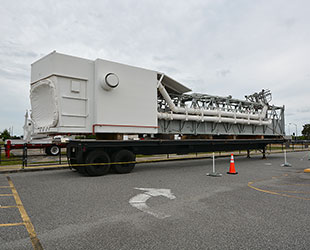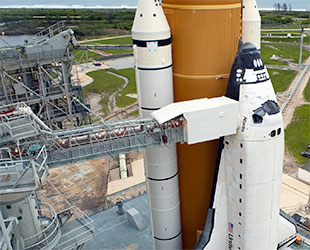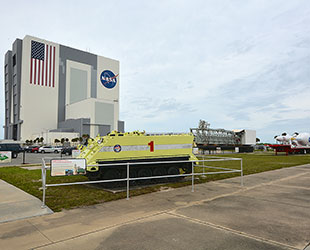May 11, 2015- A large piece of a space shuttle launch pad has landed on temporary display, where the public visiting NASA's Florida spaceport may catch sight of it.
The orbiter access arm and "white room" that for 30 years served as the astronauts' walkway into the space shuttles poised on Launch Pad 39A was recently moved outside of the Vehicle Assembly Building at NASA's Kennedy Space Center. The public may have the chance to see the gantry arm while on bus tours departing from the center's visitor complex, even getting up-close on one of the paths.
The iconic 65-foot-long (20-meter) arm and its integrated environmentally-controlled room was used by 82 astronaut crews to cross from the 147-foot (45-m) level of the pad's fixed service structure, or tower, to the shuttle that would take them to orbit. The arm and white room was first used for STS-1, the maiden flight of the space shuttle program, in 1981, and was retired with the launch of the final shuttle mission, STS-135, in 2011.

Eighty-two space shuttle crews used the Pad 39A orbiter access arm from April 1981 through July 2011. (collectSPACE) |
NASA removed the access arm and white room from 39A as it turned over use of the launch complex to SpaceX in 2013. The gantry piece was one of three specific artifacts that the agency identified for historic preservation as part of its 20-year lease with the company to use the pad for commercial space launches.
As recent as last month, the arm was being stored by the center for future display under a launch platform inside the Vehicle Assembly Building (VAB). Operational constraints however, required that it be moved sooner than planned and now it sits waiting outside the 52-story building while another indoor storage location is identified, collectSPACE has learned.
It is not yet known how long the orbiter access arm and its white room will be on outside view, or where its permanent display will be finally located.

The Pad 39A orbiter access arm and white room as seen before the final space shuttle launch on July 8, 2011. (NASA) |
For now, at least, the arm's temporary displacement is to the benefit of the public. Supported on a flatbed trailer, the arm is parked next to the fenced in tour stop where buses from the Kennedy Space Center Visitor Complex bring the public to see the VAB.
The visitor complex's KSC Up-Close Explore Tour lets the public exit the buses at this location, where a shuttle-era M113 astronaut rescue vehicle and a mock Orion launch abort system tower are also on display.
A second access arm and white room that had been used on the twin Pad 39B was previously removed in 2009 as that complex was cleared of its towers to support NASA's Space Launch System (SLS) heavy-lift booster. That arm was trucked to Johnson Space Center in Houston, where it has been on display as part of that center's rocket park since 2011.

For now, the 39A orbiter access arm has joined a space shuttle-era M113 astronaut rescue vehicle and Orion launch abort tower on display outside the Vehicle Assembly Building. (collectSPACE) |
Both launch pads' gaseous oxygen vent arms topped with their iconic external tank "beanie caps" were also removed for preservation. Pad 39B's vent arm has been on display at Kennedy's visitor complex since 2013, with the opening of the center's Space Shuttle Atlantis exhibit.
Pad 39A's vent arm is currently parked at Kennedy Space Center's Reutilization, Recycling and Marketing Facility to wait its disposition.
Access arms (and white rooms) used for NASA's Gemini and Apollo programs are on exhibit at the Kennedy Space Center Visitor Complex, the Air Force Space and Missile Museum at the Cape Canaveral Air Force Station and the Kansas Cosmosphere in Hutchinson, Kansas.
